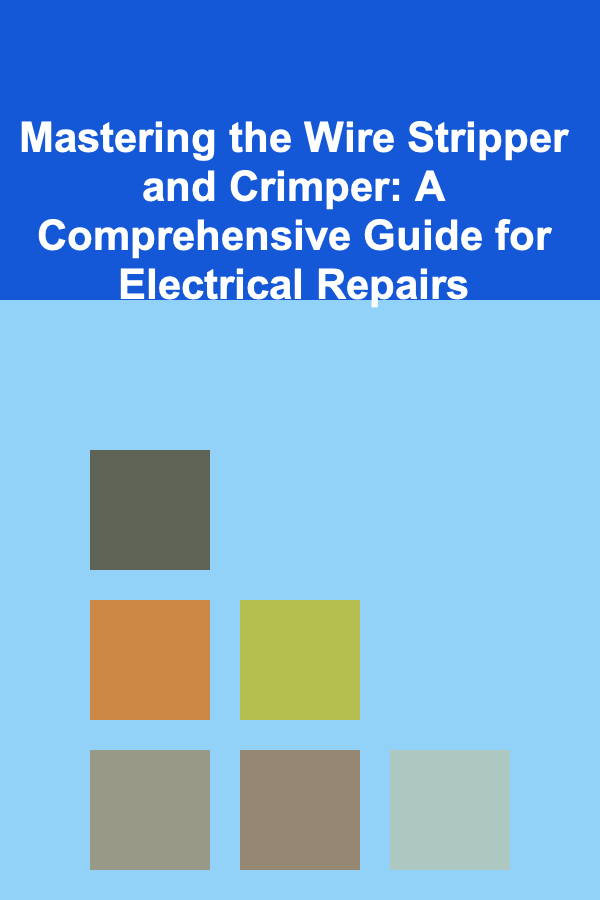
Mastering the Wire Stripper and Crimper: A Comprehensive Guide for Electrical Repairs
ebook include PDF & Audio bundle (Micro Guide)
$12.99$7.99
Limited Time Offer! Order within the next:

Electrical repairs, whether small household fixes or more complex projects, often involve working with wires. Two essential tools for anyone undertaking electrical work are the wire stripper and the crimper. These tools, when used correctly, ensure safe, reliable, and long-lasting electrical connections. This comprehensive guide provides a deep dive into understanding, selecting, and using wire strippers and crimpers effectively for various electrical repair tasks.
Understanding Wire Strippers
A wire stripper is a tool designed to remove the insulation, or outer protective layer, from electrical wires without damaging the conductive metal core. Properly stripped wires are crucial for making secure and effective electrical connections. Using a knife or other improvised tools can easily nick or cut the wires, weakening them and potentially creating a fire hazard. Wire strippers are specifically designed to avoid this.
Types of Wire Strippers
Several types of wire strippers are available, each with its own advantages and disadvantages:
- Manual Wire Strippers (Adjustable): These are the most common type. They have a series of notches or holes of varying sizes corresponding to different wire gauges (AWG - American Wire Gauge). To use them, you select the appropriate notch, insert the wire, squeeze the handles, and pull. Adjustable strippers offer versatility but require the user to correctly identify the wire gauge and select the corresponding notch. They are generally reliable and relatively inexpensive.
- Automatic Wire Strippers (Self-Adjusting): These strippers automatically adjust to the wire gauge. They typically have a spring-loaded mechanism that clamps onto the wire, strips the insulation, and then releases. Automatic strippers are faster and easier to use, particularly for repetitive tasks. They are less likely to damage the wire and are good for working with various wire gauges. However, they can be more expensive and may not be suitable for very thick or very thin wires.
- Thermal Wire Strippers: These strippers use heat to melt the insulation. They are particularly useful for stripping wires with delicate insulation materials like Teflon or Kapton, which can be easily damaged by mechanical strippers. Thermal strippers provide clean, precise stripping without nicking the wire. However, they require a power source and are generally more expensive and used for specialized applications.
- Coaxial Cable Strippers: These are designed specifically for stripping coaxial cables, such as those used for television and internet connections. They typically have multiple blades that cut through the different layers of the cable.
- Wire Stripping Pliers: Some pliers come with integrated wire stripping notches. These are a convenient option for general use, but they may not be as precise or efficient as dedicated wire strippers.
Choosing the Right Wire Stripper
The best wire stripper for you depends on the type and amount of electrical work you typically do. Consider the following factors:
- Frequency of Use: If you frequently perform electrical work, an automatic stripper may be worth the investment. If you only occasionally strip wires, a manual stripper will suffice.
- Wire Gauge: Ensure the stripper can handle the range of wire gauges you typically work with. Check the AWG range indicated on the stripper.
- Wire Type: Consider the type of insulation you'll be stripping. For delicate insulation, a thermal stripper may be necessary.
- Budget: Wire strippers range in price from inexpensive manual strippers to more expensive automatic and thermal strippers.
- Comfort and Ergonomics: Choose a stripper with comfortable handles that are easy to grip and use for extended periods.
Understanding Wire Crimpers
A wire crimper is a tool used to securely attach a terminal or connector to the end of a wire by crimping, or compressing, the metal of the terminal around the wire. A proper crimp creates a gas-tight connection that is resistant to corrosion and provides a reliable electrical pathway. Poorly crimped connections can lead to loose connections, overheating, and even electrical fires.
Types of Wire Crimpers
Crimpers come in various designs, each tailored for specific types of terminals and connectors:
- Ratcheting Crimpers: These crimpers have a ratcheting mechanism that ensures a full and consistent crimp every time. The handles lock in place until the crimp is complete, preventing partial crimps. Ratcheting crimpers are generally considered more reliable and produce more consistent results than non-ratcheting crimpers.
- Non-Ratcheting Crimpers: These crimpers are simpler and less expensive than ratcheting crimpers. They require more user skill and control to ensure a proper crimp. It's important to apply consistent pressure and fully close the crimper.
- Insulated Terminal Crimpers: These crimpers are designed for crimping insulated terminals. They typically have multiple crimping jaws for different sizes of insulated terminals. The jaws are designed to crimp the insulation and the wire separately for a secure connection.
- Non-Insulated Terminal Crimpers: These crimpers are designed for crimping non-insulated terminals. They have jaws specifically designed for bare metal-to-metal contact.
- Coaxial Cable Crimpers: These crimpers are designed for attaching connectors to coaxial cables. They typically have a die that matches the specific connector being used.
- Modular Plug Crimpers (RJ45/RJ11): These are used to crimp modular plugs onto Ethernet (RJ45) and telephone (RJ11) cables. They typically have multiple slots for different types of plugs.
- Hydraulic Crimpers: These are heavy-duty crimpers that use hydraulic pressure to create very strong crimps, often used for larger gauge wires and high-voltage applications.
Choosing the Right Wire Crimper
Selecting the appropriate crimper is crucial for creating reliable electrical connections. Consider the following factors:
- Terminal Type: The most important factor is the type of terminal or connector you'll be crimping. Ensure the crimper is designed for that specific type.
- Wire Gauge: Check the wire gauge range that the crimper can accommodate.
- Ratcheting vs. Non-Ratcheting: For consistent and reliable crimps, a ratcheting crimper is generally recommended, especially for beginners.
- Ergonomics: Choose a crimper with comfortable handles and a good grip.
- Quality and Durability: Invest in a high-quality crimper from a reputable brand to ensure it will last and produce reliable crimps.
- Specific Application: Consider the specific application. For example, if you're working on automotive wiring, you'll need a crimper designed for automotive terminals.
Step-by-Step Guide: Using a Wire Stripper and Crimper for Electrical Repairs
The following steps provide a detailed guide on how to use wire strippers and crimpers effectively for electrical repairs. Remember to always disconnect power to the circuit before working on any electrical wiring. Safety is paramount!
Step 1: Preparation and Safety
- Disconnect Power: Turn off the circuit breaker or remove the fuse that supplies power to the circuit you'll be working on. Double-check that the power is off using a voltage tester.
- Gather Materials: Assemble all the necessary materials, including the wire stripper, crimper, wire, terminals or connectors, and any other tools you may need (e.g., pliers, screwdriver).
- Wear Safety Gear: Wear appropriate safety glasses to protect your eyes from debris. Consider wearing gloves to protect your hands.
Step 2: Stripping the Wire
- Determine Wire Gauge: Identify the gauge of the wire you'll be working with. This is usually printed on the wire insulation.
- Select the Correct Notch: On a manual wire stripper, select the notch that corresponds to the wire gauge. For an automatic wire stripper, the tool will adjust automatically.
- Insert the Wire: Insert the wire into the appropriate notch or opening on the stripper. Ensure the wire is positioned correctly.
- Squeeze and Pull: Squeeze the handles of the wire stripper firmly. Rotate the stripper slightly around the wire to score the insulation. Then, pull the stripper away from the wire to remove the insulation. Avoid squeezing too hard, as this can nick or cut the wire.
- Inspect the Wire: Carefully inspect the stripped wire to ensure that the insulation has been completely removed without damaging the wire strands. If any strands are nicked or cut, cut the wire back and strip it again. The exposed wire should be clean and shiny.
- Strip Length: Typically, you'll want to strip about 1/4 to 3/8 of an inch of insulation from the wire end, but this depends on the specific terminal or connector being used. Consult the connector's instructions.
Step 3: Selecting the Correct Terminal or Connector
- Identify the Connection Type: Determine the type of connection you need to make. This will dictate the type of terminal or connector you need to use (e.g., ring terminal, spade terminal, butt connector, wire connector).
- Match Wire Gauge: Ensure the terminal or connector is rated for the wire gauge you're using. This information is usually printed on the terminal or connector packaging.
- Consider Environmental Factors: If the connection will be exposed to moisture or corrosive environments, use a waterproof or corrosion-resistant terminal or connector.
Step 4: Crimping the Terminal or Connector
- Insert the Wire: Insert the stripped end of the wire into the terminal or connector. Ensure all the wire strands are fully inserted and that no stray strands are sticking out.
- Position the Terminal in the Crimper: Place the terminal or connector in the appropriate crimping jaw of the crimper. The exact positioning will vary depending on the type of terminal and crimper. Refer to the crimper's instructions. Make sure the correct portion of the terminal (e.g., the barrel) is aligned with the crimping die.
- Crimp the Terminal: Squeeze the handles of the crimper firmly. If using a ratcheting crimper, the handles will lock in place until the crimp is complete. If using a non-ratcheting crimper, apply consistent pressure and fully close the crimper.
- Inspect the Crimp: Carefully inspect the crimp to ensure it is secure and properly formed. The terminal should be tightly crimped around the wire, and there should be no loose strands. The insulation crimp (if applicable) should grip the wire insulation firmly.
- Pull Test: Gently pull on the wire to test the strength of the crimp. The wire should not pull out of the terminal. If the wire pulls out, the crimp was not properly made, and you'll need to cut off the terminal and recrimp.
Step 5: Completing the Connection and Testing
- Connect the Wires: Once you've crimped the terminals or connectors onto the wires, connect the wires to the electrical device or circuit.
- Insulate the Connection: If necessary, insulate the connection with electrical tape or heat-shrink tubing to prevent short circuits.
- Restore Power: Turn the circuit breaker back on or replace the fuse.
- Test the Circuit: Use a voltage tester to verify that the circuit is working properly.
Tips for Achieving Perfect Crimps
Achieving perfect crimps requires practice and attention to detail. Here are some tips to help you improve your crimping technique:
- Use the Right Tool: Using the correct crimper for the terminal type and wire gauge is essential.
- Choose Quality Terminals: Using high-quality terminals and connectors will improve the reliability of your connections.
- Proper Wire Preparation: Ensure the wire is properly stripped and free of corrosion.
- Consistent Pressure: Apply consistent pressure when crimping to ensure a uniform crimp.
- Inspect Your Work: Always inspect your crimps to ensure they are secure and properly formed.
- Practice Makes Perfect: Practice crimping on scrap wire to improve your technique.
- Refer to Manufacturer Instructions: Always refer to the manufacturer's instructions for both the crimper and the terminals.
- Consider the Environment: Use weatherproof connectors in damp areas.
- Avoid Over-Crimping: Over-crimping can damage the wire and weaken the connection. Use a ratcheting crimper to avoid this.
- Use Die Sets Carefully: When using crimpers with interchangeable die sets, ensure the die set is fully seated and properly aligned.
Common Mistakes to Avoid
Avoiding common mistakes can significantly improve the quality and safety of your electrical repairs:
- Stripping Too Much Insulation: Stripping too much insulation exposes too much bare wire, increasing the risk of short circuits.
- Nicking the Wire: Nicking the wire weakens it and can lead to breakage or overheating.
- Using the Wrong Crimper: Using the wrong crimper can result in a weak or unreliable connection.
- Over-Crimping: Over-crimping can damage the wire and the terminal.
- Under-Crimping: Under-crimping results in a loose connection that can cause arcing and overheating.
- Forgetting to Disconnect Power: Always disconnect power before working on electrical wiring to avoid electric shock.
- Using Damaged Tools: Using damaged or worn-out tools can compromise the quality of your work and increase the risk of injury.
- Neglecting Inspection: Failing to inspect your crimps can lead to undetected problems and potential hazards.
Safety Precautions When Working with Electricity
Working with electricity can be dangerous if proper safety precautions are not followed. Always prioritize safety when performing electrical repairs:
- Disconnect Power: The most important safety precaution is to always disconnect power to the circuit before working on any electrical wiring.
- Use Insulated Tools: Use tools with insulated handles to protect yourself from electric shock.
- Wear Safety Gear: Wear safety glasses to protect your eyes and gloves to protect your hands.
- Work in a Dry Environment: Avoid working with electricity in wet or damp environments, as water is a conductor of electricity.
- Never Overload Circuits: Avoid overloading circuits, as this can cause overheating and electrical fires.
- Inspect Wiring: Regularly inspect wiring for damage or wear and tear.
- Use Ground Fault Circuit Interrupters (GFCIs): Use GFCIs in areas where water is present, such as bathrooms and kitchens.
- Call a Professional: If you're not comfortable working with electricity, call a qualified electrician.
- Know Your Limits: Don't attempt electrical repairs that are beyond your skill level.
- Follow Local Codes: Ensure all electrical work complies with local electrical codes.
Advanced Techniques and Applications
Beyond basic electrical repairs, wire strippers and crimpers are used in a variety of advanced applications:
- Automotive Wiring: Repairing and modifying automotive wiring systems.
- Marine Wiring: Installing and maintaining electrical systems on boats and other marine vessels.
- Networking: Crimping connectors onto Ethernet cables for computer networks.
- Electronics: Building and repairing electronic circuits.
- Home Automation: Installing and configuring home automation systems.
- Security Systems: Installing and maintaining security systems.
- Renewable Energy: Installing and maintaining solar and wind power systems.
- DIY Projects: A wide range of DIY projects involving electrical wiring.
Conclusion
Mastering the use of wire strippers and crimpers is an essential skill for anyone involved in electrical repairs or projects. By understanding the different types of tools available, following proper techniques, and prioritizing safety, you can create reliable and long-lasting electrical connections. Remember to always disconnect power before working on any electrical wiring, and if you're unsure about any aspect of the repair, consult a qualified electrician. With practice and attention to detail, you can confidently tackle a wide range of electrical tasks.

How to Create a DIY Home Scavenger Hunt for Kids
Read More
How To Create a Minimalist Wardrobe for Every Season
Read More
How to Use Breath as Your Anchor in Meditation
Read More
How to Understand the Mental Game of Esports
Read More
How to Craft a Resignation Letter Professionally
Read More
Internship Application Checklist: A Step-by-Step Breakdown
Read MoreOther Products

How to Create a DIY Home Scavenger Hunt for Kids
Read More
How To Create a Minimalist Wardrobe for Every Season
Read More
How to Use Breath as Your Anchor in Meditation
Read More
How to Understand the Mental Game of Esports
Read More
How to Craft a Resignation Letter Professionally
Read More